Anacondas will surely get your attention in the wild and are something to take in when you see them in a zoo or enclosure. There are multiple species, and some are among the largest snakes in the world. But how big are they, and how do they compare to other large snakes or animals?
First, it’s important to note that an anaconda is a specific type of snake in the Eunectes genus and the Boidae family. Other snakes within the family include boas. Many of these snakes are massive, a feature that they share. But there are ranges even within the family. One thing that does unify the Boidae family is that all of these snakes have small hindlimbs called spurs on the lower side of their bodies. They are nonvenomous and rely on their large size to take down prey.
Snake Size Comparison
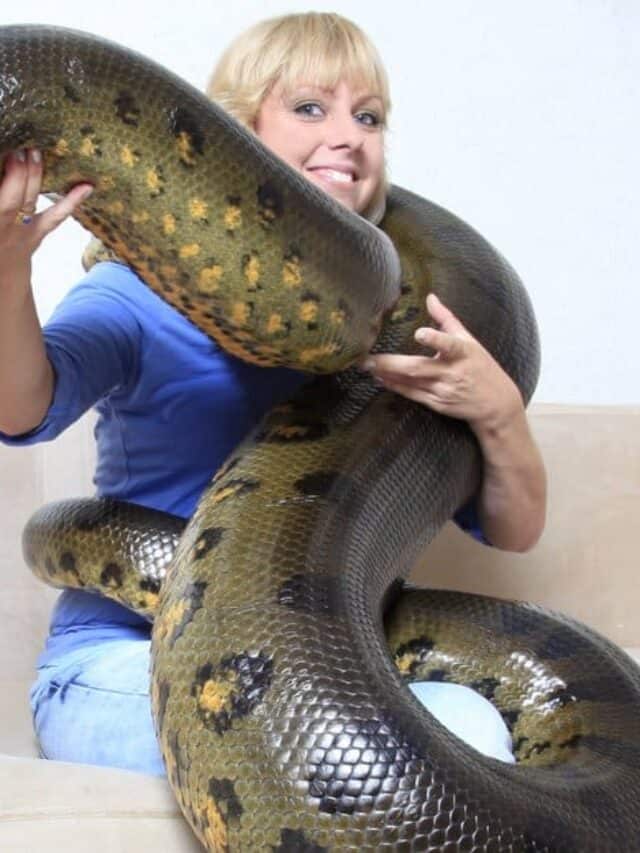
It’s helpful to know the various types of anacondas and how big they can get. After all, the size of the snake can vary widely from one kind to another. There are four types: green anacondas, yellow anacondas, dark-spotted anacondas, and Bolivian anacondas. These species live in various parts of South America.
All species use their muscular, solid bodies to trap and constrict prey. They typically wrap themselves around animals they want to eat, including small mammals, deer, birds, and even caiman. They are also very long. Green anacondas can get up to 30 feet in length! They are nonvenomous, even though they are carnivores with voracious appetites. Instead of venom, these snakes use their massive muscles to suffocate their prey before swallowing them whole.
Green Anacondas
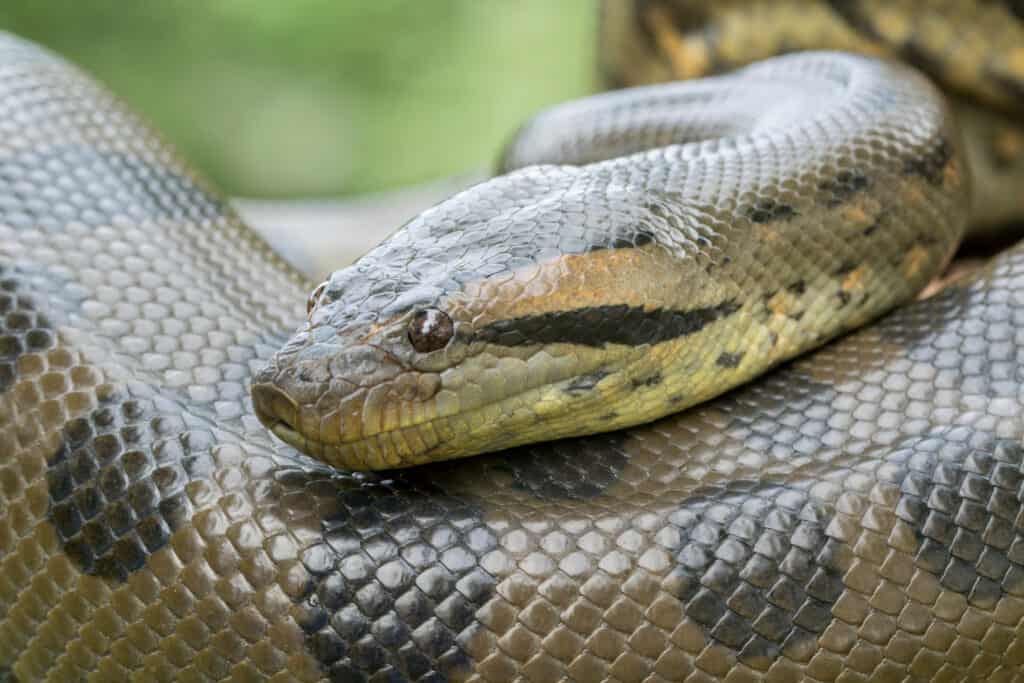
There have been about 11 sightings in Florida of the green anaconda, the largest species of snake in the world, with some individuals reaching lengths of up to 30 feet and weighing up to 550 pounds.
©Mark_Kostich/Shutterstock.com
We’ll start with the largest and most formidable species, the green anaconda. Known by the scientific name Eunectes murinus, this is the most well-recognized species within the genus. It also happens to be the largest. Females can weigh more than 500 pounds and be as long as 30 feet. A weight of 200 pounds and a length of 15 feet is not unusual. They are olive green with large dark spots on their backs and sides. They move around on their yellowish bellies. This coloring helps them blend into their environment.
One notable fact about all snakes within the family is that they are incredibly muscular with dense bodies. Green anacondas can be up to 12 inches in diameter. Holding a fully grown adult almost always requires multiple people. While attacks on humans are rare, these snakes can take down animals of similar size.
These snakes live in multiple countries in South America. They are particularly plentiful in tropical rainforests, including areas of Colombia, Brazil, Venezuela, and others. Like other snakes, anacondas need water access and prefer shallow rivers and streams. Their coloring helps them blend into environments that have plenty of plants. They are fast through the water, making it easier for them to track and catch prey. These snakes tend to be slower on land.
Yellow Anacondas
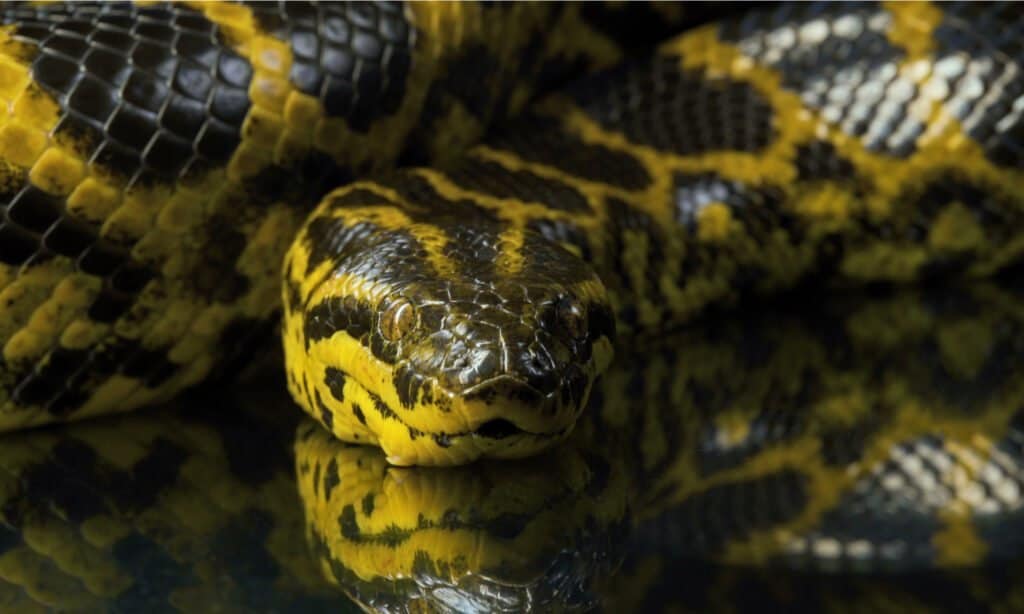
So far, sightings of these snakes, which can grow to lengths of 20 feet, have been confined to the Florida Everglades in the US.
©Chris Tefme/Shutterstock.com
These snakes are named for their bright yellow coloring. They have darker spots on their backs. Some of the most interesting yellow anacondas have bright yellow bodies with irregular black and brown spots, although their coloring can range from yellowish-green to darker yellow.
These anacondas are a bit smaller than their green counterparts. They are typically closer to 10 to 14 feet long and up to 100 pounds. They are carnivores like the other members of the boa family. All anacondas can unhinge their jaws to swallow their prey whole, and yellow anacondas are no exception. They tend to be more plentiful in the southern parts of South America. They are also known as Paraguayan anacondas, although they are also found in Brazil and Bolivia.
Dark-Spotted Anacondas

Dark-spotted anacondas live around the Amazon River Basin, incredibly rich with plant and animal life.
©piccaya/iStock via Getty Images
These snakes look like smaller versions of the green anaconda. They have olive green scales with darker spots on top, just like green anacondas. But these snakes only get around 5 to 7 feet long, rather than up to 30 feet long like the green anaconda. It has a slightly slimmer body, although it is still very muscular like all other anacondas and boas. Because it is smaller, this anaconda species tends to be faster on land than others. However, it still does better and moves faster in the water overall.
It has a much smaller range than other anaconda species. The area around the Amazon River is where dark-spotted anacondas live. They are sometimes called De Schauensee’s anaconda after the ornithologist who donated one to the Philadelphia Zoo. Because they have a small range in the wild, conservation efforts like these are significant to the species’ survival.
Bolivian Anacondas
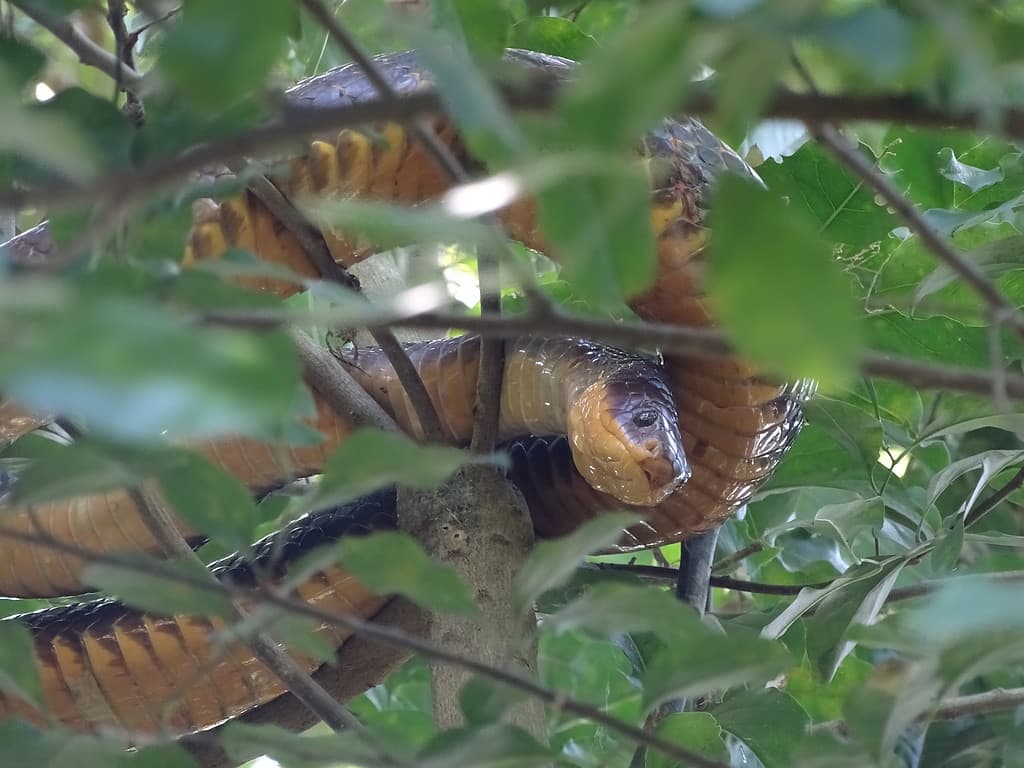
This anaconda snake in Bolivia looks down from a tree at the potential prey below.
©Nico Priewe/iStock via Getty Images
This particular species is named for the place where they live. They are also sometimes called Beni anaconda because they live in the Beni region of Bolivia. Previously, this species was considered a hybrid between green and yellow anacondas. But in 2002, they gained their classification under the scientific name Eunectes beniensis.
Bolivian anacondas are greenish-yellow with dark spots on their backs and sides. They grow to 14 feet long and tend to be around 70 pounds. Like others within this family, they move faster in the water than on land due to their large muscular bodies. They are nonvenomous carnivores that use constriction to suffocate and eat their prey.
How Big Are These Snakes When They Are Born?

Snakes use their tongues to gather information about their environment.
©Frank Cornelissen/iStock via Getty Images
Even juveniles are very large, especially when compared to other snakes. Unsurprisingly, baby green anacondas are the largest at birth since their parents are also the largest species within the genus. Females have a gestation period of around 7 months. Amazingly, these large snakes don’t eat at all while pregnant. For this reason, they tend to eat a lot during the mating season. They might even eat smaller male anacondas.
Baby green anacondas are born around 2 feet long. Litters consist of between 20 and 40 baby snakes born in the water. According to the Smithsonian, the largest litter of baby green anacondas was 82.
The Largest Anaconda Ever Recorded
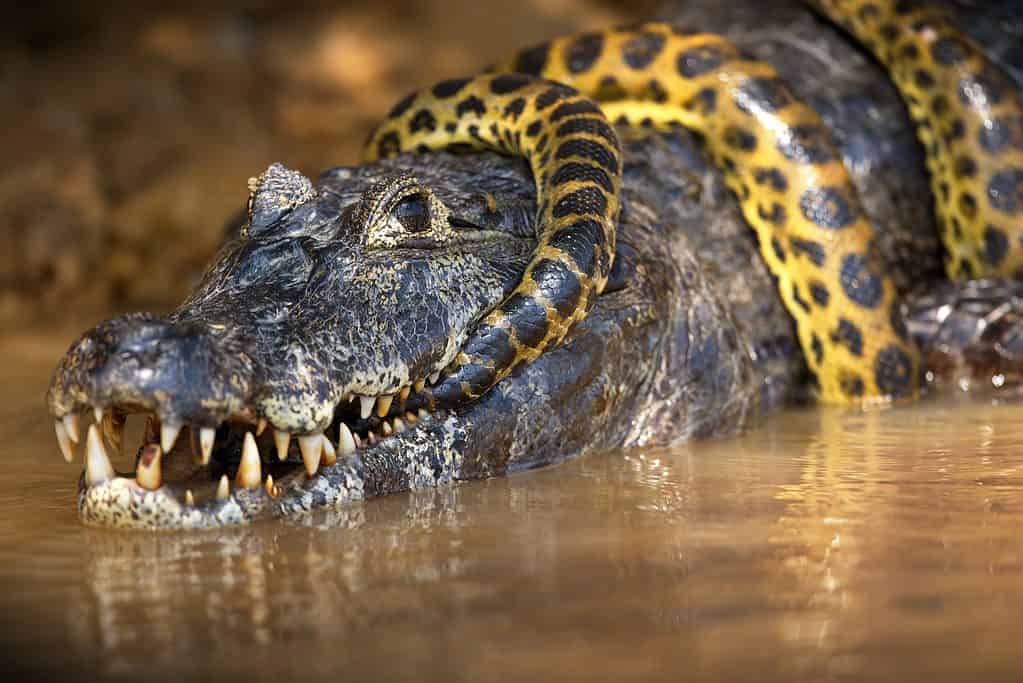
Anacondas will even take on very large animals, although they are not always successful.
©Wirestock Creators/Shutterstock.com
Even though they are genuinely massive snakes, it’s even harder to picture an unusually large anaconda. Even the normal-sized snakes are colossal. So when one specimen showed up and weighed in at 880 pounds, it was like something no one had ever seen. The snake was 33 feet long and even longer than two giraffes. It was three feet in diameter at its widest point.
Construction workers discovered the giant snake in a construction site. Unfortunately, the snake was dead when they found it. It likely lived for a long time, contributing to its large size. With such a large body, this snake must have needed to eat a lot to maintain its muscle structure. It probably didn’t have too many predators that could take it down. Even normal-sized anacondas are apex predators in their environment. This giant snake would have dominated any animal that dared to go up against it.
Are Anacondas Bigger than Pythons?
Anacondas and pythons are both large snakes. Pythons tend to be longer, often getting up to 33 feet usually. This is exceptionally long for an anaconda. However, anacondas have the upper hand on weight. These snakes can weigh 550 pounds, while pythons top out around 200 pounds.
Both types of snakes are nonvenomous carnivores who are apex predators in their environments. They both constrict their prey to suffocate them. However, they live in distinctly different areas of the world. Anacondas are native to South America, while pythons live in Asia, Africa, and Australia.
Discover the "Monster" Snake 5X Bigger than an Anaconda
Every day A-Z Animals sends out some of the most incredible facts in the world from our free newsletter. Want to discover the 10 most beautiful snakes in the world, a "snake island" where you're never more than 3 feet from danger, or a "monster" snake 5X larger than an anaconda? Then sign up right now and you'll start receiving our daily newsletter absolutely free.
Thank you for reading! Have some feedback for us? Contact the AZ Animals editorial team.








